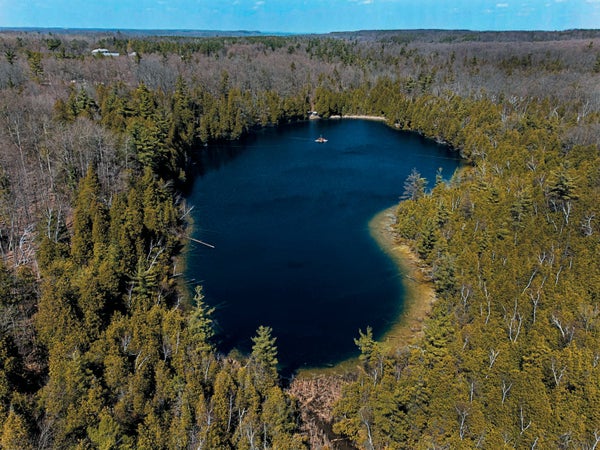January 1, 2024
Thank you for reading this post, don't forget to subscribe!4 min read
The name Anthropocene means human activity is profoundly changing our environment, and you’ll have to plan for those changes

Canada’s Crawford Lake has sediment layers that may show when human activity began to change our planet.
Credit:
Peter Power/AFP via Getty Images
In 1922 British geologist Robert Lionel Sherlock published a book, Man as a Geological Agent: An Account of His Action on Inanimate Nature, that put forth what is now considered to be the central argument for recognizing the Anthropocene as a new geological epoch: the scale and character of human activities have become so great as to compete with natural geological and geophysical forces. One hundred and one years later geologists have broadly rallied around Sherlock’s core idea, and the Anthropocene Working Group—a committee of scientists (including me) who report to the International Commission on Stratigraphy—has proposed Crawford Lake in Canada as the official site for marking the Anthropocene.
Crawford Lake contains an exceptionally well-preserved sedimentological record of environmental history. Its annual layers of lake mud, meticulously studied by geologist Francine M. G. McCarthy of Brock University in Ontario, display the “golden spike” of radioactive plutonium produced in the mid-century by atmospheric atomic bomb tests, as well as ash from coal-fired power plants, heavy metals, and microplastics.
The Crawford Lake announcement attracted a great deal of press, much of it focused on a misguided controversy that erupted over how narrowly to define the Anthropocene. Amid this hubbub, observers may have been left to wonder why defining this chapter in Earth’s history should matter to ordinary people at all.
On supporting science journalism
If you’re enjoying this article, consider supporting our award-winning journalism by subscribing. By purchasing a subscription you are helping to ensure the future of impactful stories about the discoveries and ideas shaping our world today.
Sherlock was not a maverick. He was a respected member of the British Geological Survey, and he built on the work of others who had already made similar arguments. One was American polymath George Perkins Marsh, who had called attention to deforestation and the role of humans as “disturbing agents.” In addition to revisiting deforestation, Sherlock described the altered courses of rivers through dams and canals; changes to the hydrologic cycle and to the seacoast; and the huge quantities of stuff people move while mining the raw materials of modern civilization and building streets, bridges and railroads. Human impacts were becoming so manifest, Sherlock argued, that the distinction between “natural” and “artificial” was becoming difficult to sustain. We needed a new term—he suggested “anthropography”—to study the effects of human activities on Earth.
Sherlock closed his book with a chapter on climate change, in which he drew on the arguments of two prominent scientific colleagues. One was geochemist Svante Arrhenius, who is known today as the first person to calculate the potential impact of increased atmospheric carbon dioxide on climate. The other was American geologist Thomas Chrowder Chamberlin, who had proposed that the ice ages were caused by fluctuations in CO2 levels. Chamberlin, Sherlock explained, “thinks that the Permian glaciation was a consequence of the removal from the atmosphere of the vast mass of carbon locked up by animals and plants, in the forms of limestone and coal, during the carboniferous period.” If that were so, then “we may reasonably consider the result of a reversal of the process,” which was already underway: burning those vast coal deposits was putting the CO2 back into the atmosphere, which would warm the planet—an argument that was later taken up by American oceanographer Roger Revelle, a scientific mentor to former vice president Al Gore.
In the 1950s Revelle and other scientists began the sustained study of anthropogenic climate change, and in 2000 Eugene F. Stoermer and Paul J. Crutzen formally proposed the word “Anthropocene” in a paper to reflect the idea that profound, irreversible changes were taking place.
But science is intrinsically conservative—the burden of proof is always on those making a novel claim—and the social and economic consequences of recognizing the adverse effects of burning fossil fuels have led to tremendous resistance beyond the halls of scientific conferences and the pages of scientific journals.
The definition of the Anthropocene matters for at least two reasons. The first is that it is a way for scientists to declare—as loudly as they can while still behaving as scientists—that the shifts going on around us are no small issue. Anthropogenic climate change is far more than an “inconvenient truth”; it is a profound alteration in the conditions of life on Earth. In myriad ways—large and small—the past may no longer be a reliable guide to the future. When taken seriously, that means we must rethink core assumptions about how we build our economies and our infrastructures, how we travel, how we plan for global pandemics, and even how we eat.
The second reason is that the definition of the Anthropocene extends the conversation beyond climate change. What geologists can now see in rocks—from the subtle (think changes in the ratios of carbon and oxygen isotopes) to the gross (think plastic residues in marine sediments)—points to large-scale, far-ranging and utterly pervasive human impacts.
It is common for people to say (or think) that as climate change proceeds, we can “just adapt.” Some wealthy people even think that, if necessary, they will move to higher ground or lower latitudes (or, preposterously, to Mars). No doubt some people will become climate refugees, either voluntarily or under duress. But the definition of the Anthropocene reminds us that the challenge we face is geological in scale. It affects the whole Earth. It reminds us that as this new epoch unfolds, there won’t be anywhere to hide.
This is an opinion and analysis article, and the views expressed by the author or authors are not necessarily those of Scientific American.

